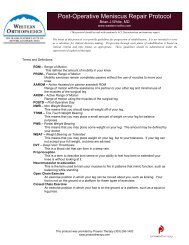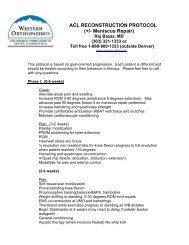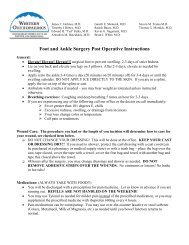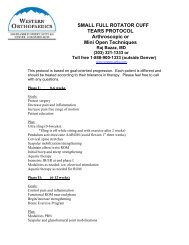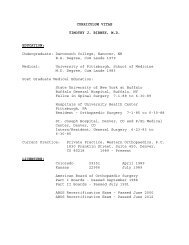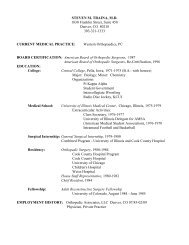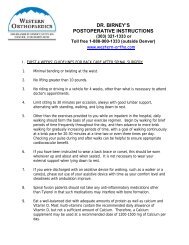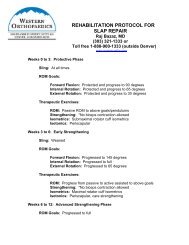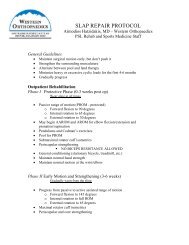Anterior Hip
Anterior Hip
Anterior Hip
- No tags were found...
Create successful ePaper yourself
Turn your PDF publications into a flip-book with our unique Google optimized e-Paper software.
GeneralFrequently Asked QuestionsQ:What is Total <strong>Hip</strong> Replacement Surgery?A: Your hip joint is composed of two parts: the round head of the femur (the ball) and theacetabulum (the cup or socket in your pelvis). In a normal hip joint these two bones are coatedwith smooth articular cartilage that allows them to move against each other without friction orpain. In an arthritic hip, the cartilage layers are destroyed and bone rubs against bone causing painand limiting motion.<strong>Hip</strong> replacement surgery replaces your arthritic hip joint with an artificial joint composed of a ballcomponent and a socket component. The metal ball is attached to a stem that fits into your thighbone. This component can be cemented or non-cemented depending on your age and thecondition of your bone. A plastic liner with an outer metal shell is secured into your pelvis. Acombination of a cemented ball and a non-cemented socket also may be used.Q: How long will a joint replacement last?A: The average time length is 15+ years, however with advancing technology the life expectancy forthese implants continues to increase. There are other factors that affect the longevity of your newjoint such as your age, weight, activity level and medical conditions.Q: What types of implants are used to replace my joint?A: Most implants are a combination of metal (to replace the worn bone surface) and polyethylene(to replace the worn cartilage surface). Other options include metal-on-metal, metal-on-ceramicand ceramic-on-ceramic. Many different manufacturers make these implants and your surgeon willdecide on the size, the type of implant and the method used.Q: What are the major risks of joint replacement surgery?A : While risks are low, they do exist with every surgery. The two most serious complications areinfection and blood clots. To avoid these problems, we use antibiotics and blood thinners. We alsotake special precautions in the operating room to reduce the risk of infections.ActivityQ:When can I start driving?A: There are two major considerations before you can start driving: you will need to be able toreact to emergency situations and you must be off your pain medications. Usually most patients areable to meet this criteria after two weeks of surgery, however this should be further discussed withyour physician.



